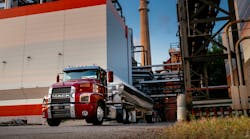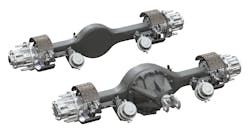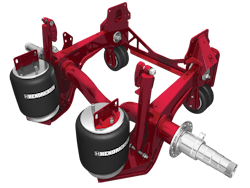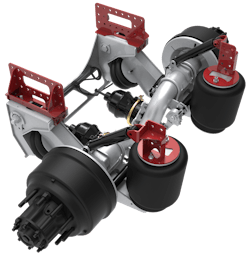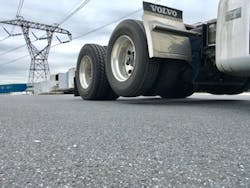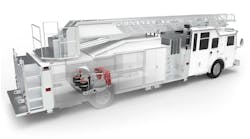How fleets can benefit from today’s 6x2 axle configurations
The 6x2 axle configuration has been around for decades. Just ask Joel Morrow. His family’s trucking business has been using both 6x4s and 6x2s for 40-plus years. Nowadays, Morrow has come to prefer a 6x2.
“I have learned all the little quirks over the years,” says Morrow, senior driver and head of research and development for Ploger Transportation in Norwalk, Ohio. “Now I prefer 6x2s, even in snowy weather. You can actually get better traction as long as you understand the aspect of weight distribution.”
Traditionally though, traction has always been one of the generally accepted downsides of a 6x2, notes Morrow. With a 6x4, both rear axles are powered axles which helps with traction, whereas a 6x2, has only one of the rear axles powered. Additionally, a 6x4 provides more power and torque since both rear axles are receiving power.
Resale value is another reason why some fleets have shied away from 6x2s. Since 6x4s continue to outsell 6x2s by a wide margin, there isn’t a terribly large market for used 6x2s.
All of those factors have continued to thwart the more widespread adoption of 6x2 axle configurations. However, 6x2s offer a couple of unmistakable benefits where many fleets are placing higher levels of importance: fuel economy and weight. Additionally, new design approaches and the leveraging of technology are making certain 6x2 configurations more functional, versatile, and cost effective.
“For fleets that really pay attention to the details and work with OEs and tire manufacturers to get the best configuration for their operation, the 6x2 axle is a real opportunity going forward,” says Joel Van Den Brink, senior engineer for Link Manufacturing, a manufacturer of suspension systems including lift axles for commercial vehicles.
6x2 axle configurations
There are two general types of 6x2 axles. A tag axle is where the rear-most drive axle is non-powered, also referred to as a free-rolling or dead axle. A pusher axle is where the forward-most drive axle is not powered.
The tag axle has been the most common. It is generally perceived to have traction issues in challenging conditions. Tire wear can also be an issue. All four rear tires are on the road at all times. Since only two of those tires are powered, they can tend to wear faster.
A 6x2 pusher axle helps reclaim some of those downsides. First of all, the powered drive axle remains in the far back which aids traction. Secondly, due to the fact that it is positioned upfront, a pusher axle can be lifted when not needed, which helps reduce tire wear.
According to Steve Mastroianni, senior manager of product planning for axles at Dana, a leading drivetrain and propulsion systems provider, a tag axle is more than adequate in areas south of Interstate 40, which runs east to west from northern Arizona through North Carolina. That is because those southern environments present minimal scenarios where traction is significantly compromised due to weather conditions.
When operating in more northern environments, Mastroianni says a pusher configuration becomes more favorable. “A pusher definitely has some advantages in places where there is inclement weather,” Mastroianni says.
“With a pusher axle, drivers can sort of ‘stretch the wheelbase’ by applying power far back behind the fifth wheel where they’re probably going to have more of a weight loading,” says Scott Donnelly, aftermarket training and senior quality engineer for Dana.
Conversely, with a tag axle, power is applied at the forward axle.
“The rear axle of a tag is still going to provide stability and load-carrying capability,” Donnelly points out.
The type of 6x2 configuration that makes the most sense for a fleet will depend on what the tractor-trailer is transporting, where the load is being transported, and how often the truck travels with a less than full load.
Benefits of 6x2 axles
The primary benefit of using a 6x2 axle is improved fuel economy as only one of the rear axles is powered. When the non-powered axle is liftable in the pusher position, the fuel savings can be even more impactful.
“A liftable pusher axle reduces rolling resistance which further improves fuel economy,” says Michael Hof, vice president of business development for Link Manufacturing which offers a 6x2 liftable pusher. “Some fleets that are more experienced with 6x2 pushers are getting anywhere from 10 to 12 miles per gallon.” Data on Link Manufacturing’s website suggests a 3 to 5 percent improvement in fuel economy compared to a 6x4 axle.
Roy Horton, director of product strategy for Mack Trucks, a manufacturer of heavy duty Class 8 trucks, engines, and transmissions, notes that depending on the application, 6x2 pusher axles can provide substantial cost and time savings to a fleet.
“Applications involving light loads or driving empty on one leg of a route are good examples,” Horton says.
Mack’s Liftable Pusher Axle features weight sensors in the truck that can detect an empty, partially full, or full trailer, and automatically raise or lower the pusher axle to help maximize fuel efficiency.
“The system also automatically distributes weight between the pusher and rear axle to enhance traction,” Horton says. Drivers can manually override the system as needed.
Hendrickson, a manufacturer of truck, tractor, bus, and recreational vehicle suspensions, axles, and other products, manufactures its own liftable pusher axle.
“Our Optimaax forward liftable axle lifts when the tractor is lightly loaded or in a bobtail for additional fuel economy,” says Mark Williamson, on-highway segment manager for Hendrickson.
Reduced weight is a second benefit of 6x2 axles. As Link Manufacturing’s Van Den Brink points out, since the non-powered axle doesn’t need internal gearing or a driveshaft, it can shed several hundred pounds. This can be an important benefit to fleets that are especially concerned about weight and cargo-carrying capacity.
Hendrickson’s Williamson says a 6x2 pusher is ideal for a fleet with diminishing load applications such as bulk haulers, grocery, livestock, beverage, or applications experiencing empty back hauls.
Fleets can also reduce their tolls with a liftable pusher axle.
“Lifting an axle reduces axle count,” Van Den Brink says.
As touched on earlier, Williamson says a common complaint from drivers who have run 6x2s is lack of traction, especially when backing under a trailer. However, when a tractor is configured with a 6x2 pusher such as Hendrickson’s Optimaax, traction can be improved.
“We have also heard from our fleet customers that the ride is better, especially when lightly loaded or in a bobtail,” Williamson says.
As Van Den Brink explains, the drive axle remains behind the fifth wheel in a pusher configuration, which increases tire friction. Then, when the tractor has the right control system, the driver can maximize load on the single drive axle. “Users of our 6x2 pusher have actually told us they get better traction than a 6x4 because they are getting that maximum load on one drive axle,” Van Den Brink says.
Ploger Transportation’s fleet includes both 6x4s and 6x2s on Volvo and Mack trucks. Morrow says the weight distribution logic that is part of the Volvo system has made all the difference.
“Not only does the system know when it’s time to lift the axle, but it also has an algorithm to help bias weight to the drive axle,” Morrow says. That’s how a 6x2 liftable pusher axle can provide enhanced traction.
With a tag axle, on the other hand, the drive axle is in front which makes it difficult to achieve optimum weight transfer.
“Traction and tire life really suffer,” Morrow adds.
Speaking of tire life, liftable pusher axles can also reclaim some of that negative stigma associated with 6x2 tags. Weight transferring, as Morrow just explained, is an important part. The other part is that with tag axles, all four rear tires are on the road at all times, whereas liftable pushers take two tires off the road when not needed, therefore increasing the life of those tires. Additionally, data from Link Manufacturing and Mack Trucks shows that tire life with a 6x2 liftable pusher can be improved by up to 20 percent compared to a 6x4.
If you'd like more information and articles like this in your inbox, subscribe to the Fleet Maintenance Today newsletter.
6x2 specification advice
All in all, with the correct logic and torque, Morrow believes a 6x2 liftable pusher axle is on par or better than a 6x4 in just about any on-highway application. Fuel economy has been the biggest benefit.
“We’re getting another half-mile per gallon at least,” Morrow says.
Some of Morrow’s fuel savings used to go right into tire replacements. Now he has figured out how to reduce wear and extend life so that isn’t necessary.
“We’ve learned to avoid using wide-based tires on 6x2s because all the power and torque are going through just two tires,” Morrow explains. “Instead, we use tires with moderate rolling resistance and more traction.”
Along with tires, Morrow says he has learned a few other lessons about how to properly specify a tractor-trailer with a 6x2 pusher axle:
- Since the goal is to get the lift axle off the ground as much as possible, go with a heavier (i.e. 14,000 lbs) front steer axle.
- Pay attention to engine size and weight. An 11L or 13L engine can provide power and torque on par with a 15L engine, and the lighter weight engine will help when it comes to weight transfer and lifting of the axle.
- With a 6x2, numerous oil and gear sets are eliminated, therefore power transfer to the drive axle is more efficient. Thus, 450 hp will pull just as well as 500 hp.
Morrow says it is also a good idea to consider a transmission with a crawler gear — even if you’re in a general freight application.
“You need 25 percent of gross combination vehicle weight on the drive axle to maximize traction,” Morrow explains. “It’s easy to do that when you’re light and the pusher axle comes up. But when you’re heavy and need to maintain legality on the axles, the axle drops, and you have a hard time meeting that 25 percent on the drive axle. Maybe you only get 18 percent. To compensate, a crawler gear will help you get started on slippery surfaces with a heavy load.”
Dana’s Mastroianni says fleets often develop their own preferences on how they like to specify their vehicles for 6x2 axles.
“Some try to lightweight the upfront area of the truck, maybe going with a slightly smaller engine, just to balance things out more favorably so they aren’t as front-end heavy,” Mastroianni relates. “Some fleets prefer wide-base singles while others prefer dual tires. Some like torque-reactive suspensions while others do not. There are all kinds of tweaking fleets can do with 6x2s to get the most favorable vehicle dynamics they are looking for.”
In the case of Dana 6x2 axles, Mastroianni says the company offers various features that help support a truck being configured in the right way to maximize traction. Examples include wider axle housings to provide the right track width to support the vehicle and thicker wall housings to accommodate various weight ratings.
“Those features are really important because you don’t want to just make everything wider and thicker,” Mastroianni points out. Doing so could end up offsetting any weight savings the 6x2 axle provides.
Another feature from Dana is the driver-controlled wheel differential lock.
“This becomes a highly used feature for those fleets concerned with traction,” Mastroianni says.
Maintaining a 6x2 axle
Hendrickson’s Williamson says servicing the company’s Optimaax liftable pusher axle is really no different than a 6x4, except for the additional lift air bags to inspect when maintaining the tractor.
“As with a 6x4 tractor, the shocks and air springs should be checked for leaks,” Williamson points out. “Also, it’s important to check that the bolted joints are still at the proper torque per the OEM recommended intervals. One difference is the type of tires that are used on the Optimaax axle. Trailer tires should be used instead of drive axle tires for optimal savings.”
Link Manufacturing’s Van Den Brink says maintenance is generally simplified with a 6x2 because there are fewer driveline components.
“One thing to keep in mind is that a non-drive axle can be susceptible to brake shoes freezing or rusting to the drum since they are not driven all of the time,” Van Den Brink points out. “Drivers should make sure the wheel ends rotate during their pre-trip inspections.”
Prospects for adoption and growth
The 6x2 axle is still a bit of a niche product, currently embraced by roughly 5 percent of the long-haul and line-haul market. Van Den Brink points to applications like fuel hauling where the tanker is often running at half-load and both rear axles are not always needed. Another well-suited application is bulk haulers where an extra 400 lbs of cargo-carrying capacity can be a huge help.
Link Manufacturing’s Hof believes adoption of the 6x2 axle will increase as fleets come to understand their options. “A liftable pusher axle eliminates many of the downsides of the traditional tag axle many fleets have come to know,” Hof says.
Any kind of significant upward momentum with fuel prices could also increase demand for 6x2s.
“The only thing I see holding demand back is suppressed fuel prices,” Hof says. “Most trucks are not maxed out in weight, so they don’t need all axles on the ground at the same time. When you’re often running with less than a full load, a 6x2 with a liftable pusher makes a lot of sense.”
If you'd like more information and articles like this in your inbox, subscribe to the Fleet Maintenance Today newsletter.
